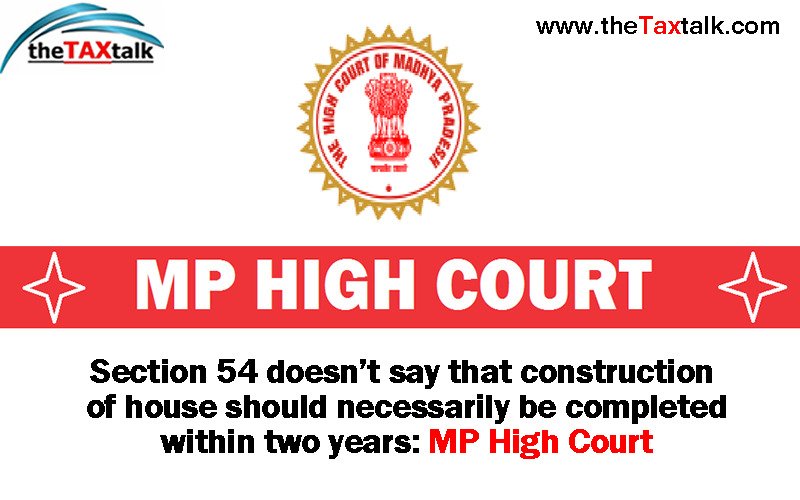![]()
Section 54 doesn’t say that construction of house should necessarily be completed within two years: MP High Court
MP High court in the case of Smt. Shashi Varma vs CIT has held that construction of house should not necessarily be complete within two years. If the substantial investment is made in the construction of house, then it should be deemed that sufficient steps have been taken and this satisfies the requirements of Section 54.
The court observed as under:
“This clinches the matter and it was not proper for the Tribunal to have ignored the circular because it has a persuasive value and it was in the nature of granting relief. Therefore, the Tribunal should have considered the circular sympathetically and granted the relief. More so, Section 54 of the Act of 1961 only says that within two years, the assessee should have constructed the house but that does not mean that the construction of house should necessarily be complete within two years. What it means is that the construction of house should be completed as far as possible within two years. In the modern days, it is not easy to construct a house within the time-limit of two years and under the Government schemes, construction takes years and years, Therefore, confining to two years’ period for construction and handing over possession thereof is impossible and unworkable under Section 54 of the Act. If substantial investment is made in the construction of house, then it should be deemed that sufficient steps have been taken and this satisfies the requirements of Section 54. Therefore, the view taken by the Tribunal is not correct. Hence, we answer the question in favour of the assessee and against the Revenue.”
The copy of the order is as under:
Madhya Pradesh High Court
Smt. Shashi Varma vs Commissioner Of Income-Tax on 15 March, 1996
Equivalent citations: 1997 224 ITR 107 MP
Bench: A Mathur, S Kulshrestha
JUDGMENT
-
This is a reference application under Section 256 at the instance of the assessee and the following question of law has been referred by the Tribunal for answer by this court :
” Whether, on the facts and in the circumstances of the case, the Tribunal was justified in denying the assessee exemption under Section 54 in regard to surplus realised on the sale of residential property at Jabalpur and invested with the Delhi Development Authority for the acquisition of a flat ?”
-
The brief facts giving rise to this reference are that the assessee is an individual and owned a property in Jabalpur. During the previous year relevant to the assessment year 1982-83, the assessee sold this property on December 29, 1981, and realised capital gains of Rs. 31,980. She invested a sum of Rs. 71,256 for the purchase of a flat in Delhi from the Delhi Development Authority. The sum represented the first instalment. Before the Income-tax Officer, exemption under Section 54 was claimed by the assessee in regard to the surplus realised on the sale of the residential house at Jabalpur. This was denied by the Income-tax Officer. Thereafter the matter was taken in appeal before the Appellate Assistant Commissioner who also upheld the order of the Income-tax Officer. Ultimately, the Tribunal also upheld the finding of the Income-tax Officer. Hence, the assessee approached the Tribunal for making a reference to this court. Therefore, the Tribunal has referred the aforesaid question of law for answer by this court.
-
We have heard counsel and perused the record. In fact, the Tribunal has taken a very pedantic approach while construing the provisions of Section 54of the Income-tax Act. In the present case, in fact, the capital gain is Rs. 51,980 ; whereas the first instalment towards the flat from the Delhi Development Authority was Rs. 71,256, i.e., much more than the capital gains. The Central Board of Direct Taxes also issued Circular No. 471 (see [1986] 162 ITR (St.) 41), dated October 15, 1986, and has clarified as under :
” Therefore, for the purpose of capital gains tax, the cost of the new asset is the tentative cost of construction and the fact that the amount was allowed to be paid in instalments does not affect the legal position stated above. In view of these facts, it has been decided that cases of allotment of flats under the self-financing scheme of the Delhi Development Authority shall be treated as cases of construction for the purpose of capital gains. “
-
This clinches the matter and it was not proper for the Tribunal to have ignored the circular because it has a persuasive value and it was in the nature of granting relief. Therefore, the Tribunal should have considered the circular sympathetically and granted the relief. More so, Section 54of the Act of 1961 only says that within two years, the assessee should have constructed the house but that does not mean that the construction of house should necessarily be complete within two years. What it means is that the construction of house should be completed as far as possible within two years. In the modern days, it is not easy to construct a house within the time-limit of two years and under the Government schemes, construction takes years and years, Therefore, confining to two years’ period for construction and handing over possession thereof is impossible and unworkable under Section 54of the Act. If substantial investment is made in the construction of house, then it should be deemed that sufficient steps have been taken and this satisfies the requirements of Section 54. Therefore, the view taken by the Tribunal is not correct. Hence, we answer the question in favour of the assessee and against the Revenue.

